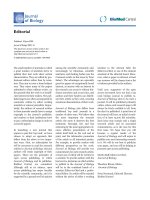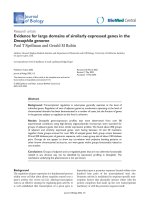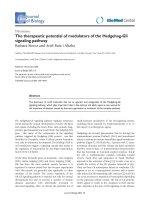Báo cáo sinh học: "The long term effects of chemotherapy on the central nervous system" docx
Bạn đang xem bản rút gọn của tài liệu. Xem và tải ngay bản đầy đủ của tài liệu tại đây (67.74 KB, 4 trang )
Minireview
The long term effects of chemotherapy on the central nervous
system
Patricia K Duffner
Address: Department of Neurology, Women and Children’s Hospital of Buffalo, University of Buffalo School of Medicine, 219 Bryant St.,
Buffalo, NY 14222, USA. Email:
Although the long-term effects of irradiation on the central
nervous system (CNS) are now well-known and accepted,
the long term consequences of most chemotherapeutic
agents have rarely been considered, either in the develop-
ment of multi-institutional cancer group studies or in the
follow-up of survivors. In this issue of Journal of Biology,
Mark Noble and colleagues [1] describe an interesting and
important series of experiments that helps define the
cellular basis for cognitive decline and white matter diseases
(leukoencephalopathy) in patients treated with chemotherapy.
Noble and colleagues [1] have now shown that standard
chemotherapeutic agents, given in dosages comparable
to those used in the clinical arena, are even more toxic
to CNS progenitor cells and oligodendrocytes than they
are to cancer cell lines, causing both decreased cell
division and cell death. The authors conducted four
groups of experiments. In the first, DNA cross-linking
agents - 1,3-bis(2-chlorethyl)-1-nitrosourea (BCNU) and
cisplatin (CDDP) - were applied in vitro to purified
populations of neuroepthelial stem cells, neural-restricted
precursor cells, glial-restricted precursor cells, and
oligodendrocyte precursor cells (O-2A/OPCs) as well as to a
variety of human cancer cell lines. They found that clinically
relevant concentrations of BCNU or CDDP were more toxic
to lineage-committed precursor cells and neuroepithelial
stem cells than to cancer cells. These effects were seen even
at very low levels of exposure. Moreover, the vulnerability
was not restricted to dividing cells, as non-dividing
oligodendrocytes were as much at risk as the rapidly
dividing neural progenitor cells.
In the second in vitro experiment, O-2A/OPCs exposed to
sublethal concentrations of CDDP and BCNU were found
to have both reduced cell division and increased differen-
tiation into oligodendrocytes. Thus, the chemotherapy
compromised the ability of the O-2A/OPCs to continue cell
division and form new precursor cells.
In the third experiment, mice were treated systemically with
BCNU and CDDP and then examined for evidence of cell
death and cell division in the CNS. As with the in vitro
experiments, neuronal and glial progenitor cells and
oligodendrocytes were adversely affected, particularly in the
subventricular zone, the corpus callosum and the dentate
gyrus of the hippocampus. By examining incorporation of
bromodeoxyuridine (BrdU) in adult animals, the authors
found that cell proliferation in putative germinal zones was
Abstract
Cranial radiotherapy is known to have adverse effects on intelligence. A new study shows that
chemotherapy is also toxic to the central nervous system, especially to neural progenitor cells
and oligodendrocytes. By identifying the cell populations at risk, these results may help explain
the neurological problems previously seen after chemotherapy.
BioMed Central
Journal
of Biology
Journal of Biology 2005, 5:21
Published: 30 November 2006
Journal of Biology 2006, 5:21
The electronic version of this article is the complete one and can be
found online at />© 2006 BioMed Central Ltd
reduced for at least 6 weeks following repeated injections of
BCNU. Overall, the effects of CDDP were more transient
than those produced by BCNU.
In the fourth experiment, AraC (an antimetabolite) was
found to be highly toxic in vitro for neural progenitor cells
in concentrations equivalent to those used in clinical trials.
As with BCNU and CDDP, O-2A/OPCs were more sensitive
to adverse effects than were the leukemia and lymphoma
cell lines. In addition, sublethal concentrations of the drug
were associated with suppression of cell division in clonal
assays. Systemic treatment with AraC in vivo was also
associated with cell death and reduced cell division in
neuronal and oligodendrocyte precursors. Thus, despite a
different mechanism of action, AraC had similar effects on
the same cell populations as BCNU and CDDP.
The effect of radiation
This fascinating study is likely to act as a wake-up call for
neuro-oncologists. To put the work into perspective,
concerns about the long-term effects of CNS radiation were
first raised in the early 1980s regarding children treated for
brain tumors. Our group had reported that, of 10 children
with posterior fossa tumors treated with surgery, cranio-
spinal radiation and chemotherapy, all had evidence of
either mental retardation, cognitive decline and/or learning
disorders, and 40% had IQs less than 70 [2]. Others
reported similar findings [3,4]. Although some children had
also received chemotherapy, the overwhelming consensus
was that cranial irradiation was the culprit. Two subsequent
prospective studies of children irradiated for brain tumors
also revealed significant cognitive decline from the baseline
after only two years of follow-up [5,6].
Over the next decade, late-effects studies focused on first
identifying risk factors for radiation-induced cognitive
decline and then modifying treatments to reduce neuro-
toxicity [7]. Two of the most important of the risk factors
are high dose and large volume radiation (craniospinal
versus whole brain versus local) radiation. The response of
investigators has been to reduce the dose and/or volume of
radiation and, in some cases, to eliminate radiation entirely,
adding combination chemotherapy to the treatment
regimens instead. For example, attempts to reduce the dose
of radiation to the brain and spinal cord from 3,600
centiGray (cGy) to 2,400 cGy led to the development of a
protocol in which reduced craniospinal radiation was
coupled with chemotherapy. The agents included a nitroso-
urea, CDDP and vincristine [8]. Of the patients treated in
this way, 80% survived, suggesting that reduced CNS
radiation was a viable therapeutic option if adjuvant
chemotherapy was also given. Unfortunately, despite the
dose reduction, a 15 to 20 point decline in IQ for most
patients was identified. Although future studies are planned
that further reduce the dose of craniospinal radiation to
1,800 cGy, virtually no attention has been paid to the
possible contribution of the chemotherapy to the cognitive
decline. Note that a nitrosourea (BCNU) and CDDP were
found to be toxic to neural progenitor cells even in low
doses by Noble and colleagues [1].
The greatest risk factor for radiation-induced cognitive
decline is young age at the time of treatment. Cranial
irradiation can be so devastating to the brains of young
children (under three to five years) that, by the mid 1980s,
many families opted not to treat babies and very young
children who had malignant brain tumors. As a result, the
US multi-institutional cancer treatment groups radically
altered what had been considered ‘standard’ therapy
(craniospinal radiation) by first delaying and then, in
subsequent trials, eliminating radiation in certain ‘good
risk’ children by using a regimen of prolonged post-
operative combination chemotherapy (CDDP, cyclophos-
phamide, vincristine and etoposide) [9]. Current and
proposed studies for infants with malignant brain tumors
use even higher doses of chemotherapy, necessitating either
bone marrow transplantation or peripheral stem cell support
to boost the immune system, and either no craniospinal
radiation or focused radiation to the tumor bed. The
increased risk of neurotoxicity associated with very high doses
of chemotherapy is clearly demonstrated by Noble and
colleagues [1], yet these proposed studies do not take into
consideration the possible effects of high-dose chemotherapy
on either CNS progenitor cells or oligodendroglia in this very
young, and hence vulnerable, population of patients.
Chemotherapy-induced cognitive decline in
the absence of radiation
The best data on the cognitive effects of chemotherapy alone
have come from studies of children with leukemia who did
not have CNS leukemia. Unlike children with brain tumors -
for whom there are many confounding variables that could
influence intellect adversely, such as hydrocephalus, surgery,
epilepsy, anticonvulsant therapy, as well as the tumor itself -
children with leukemia receive chemotherapy as a
preventative measure (CNS prophylaxis) and, therefore, have
no specific risk factors for cognitive dysfunction. Rowland et
al. [10] reported in 1984 that children with acute
lymphoblastic leukemia (ALL) who had been irradiated for
CNS prophylaxis had significantly lower IQs and worse
performance on Wide Range Achievement Tests than
children treated with chemotherapy alone (methotrexate
injected either intrathecally (into the cerebrospinal fluid) or
intravenously and intrathecally). This study and many
21.2 Journal of Biology 2006, Volume 5, Article 21 Duffner />Journal of Biology 2006, 5:21
others confirmed the prevailing belief that chemotherapy,
in the absence of radiation, did not affect intellect.
In addition, ‘methotrexate leukoencephalopathy’, first repor-
ted in 1978 and characterized on computed tomography
(CT) scans as calcifications in the basal ganglia, cerebral
atrophy and less dense areas in the white matter, was
reported in children with ALL treated with cranial radiation
and methotrexate [11], whereas children treated with
methotrexate but no radiation did not suffer this complica-
tion. The only exception to this was those children with
CNS leukemia who were unable to clear the methotrexate
from the cerebrospinal fluid [12].
It was concluded from these early studies that adminis-
tration of methotrexate was safe if children had no CNS
disease and were not irradiated. This concept was widely
accepted until 1997, when we identified a group of non-
irradiated children with ALL without CNS leukemia who
developed evidence of methotrexate leukoencephalopathy
on CT and magnetic resonance imaging (MRI) scans
associated with concomitant cognitive changes
(unpublished data). A subsequent group-wide study of
neuroimaging and IQ testing of children treated for
leukemia confirmed these preliminary findings of
methotrexate-induced leukoencephalopathy in patients
that had been considered to be at low-risk [13]. Moreover,
40% of the children in that study had IQs less than 85, a
striking difference from the average. As the dose and
frequency of administration of methotrexate had been
gradually increased over the previous two decades, the
earlier optimistic predictions that methotrexate could be
given with impunity were no longer valid.
Further evidence of the development of methotrexate-
induced leukoencephalopathy in the absence of cranial
radiation was shown in a German study of infants with
medulloblastoma treated with high-dose intravenous
methotrexate (5 g/m
2
) and also methotrexate injected into
the brain cavities (intraventricular injection), together with
other chemotherapy, but no radiation [14]. Only 4 of 23
children failed to develop leukoencephalopathy. A
correlation was found between the cumulative dose of intra-
venticular methotrexate and the grade of leukoencephalo-
pathy, but not the number of doses of intravenous metho-
trexate. Although children in this study fared better
cognitively than those who had been irradiated in a
previous trial, the mean IQ was still significantly lower than
controls. Despite these findings, as well as the accumulating
data on methotrexate leukoencephalopathy in non-irradiated
children with leukemia, one arm of a proposed inter-
national study for infants with medulloblastoma will
include high dose intravenous methotrexate (unpublished
data). Concerns over the German experience [14], however,
convinced investigators to withhold intraventricular
methotrexate from the trial.
It is becoming increasingly clear that not only CNS
irradiation but also chemotherapy alone can cause severe
neurotoxicity leading to cognitive decline and leuko-
encephalopathy (not to mention secondary malignancies
and adverse effects on endocrine function and growth). The
pediatric neuro-oncology community has recognized the
adverse effects of CNS radiation and has modified treatment
with the dual goals of lessening late effects while main-
taining acceptable survivals. In order to accomplish this,
however, chemotherapy in increasing doses has become
routine. Very high dose chemotherapy, requiring bone
marrow transplantation or peripheral stem cell support, is
now standard therapy for children with certain brain
tumors, especially for the very young. Because of the rapid
myelinization that occurs in infants, the finding by Noble
and colleagues [1] of the adverse effects of chemotherapy on
oligodendrocytes are especially troubling. Mulhern et al.
[15] had previously found a correlation between cognitive
deficits in very young children treated with CNS radiation
with or without chemotherapy and white matter loss, as
identified on quantitative MRI scans. They attributed the
reduction in normal-appearing white matter to radiation-
induced damage to oligodendrocytes and endothelial cells
[15]. It would be important to determine whether infants
treated with chemotherapy alone develop a similar reduc-
tion in normal-appearing white matter, as might be
anticipated based on the finding by Noble and colleagues of
loss of cell division of O-2A/OPCs following chemotherapy
exposure, which would presumably lead to an inability to
repair damaged myelin.
There are no easy answers. We must balance the need for
survival with quality of life. In the mean time, until
effective targeted therapy sparing normal tissue is
developed or neuroprotective therapies are available, we
will need to continue using various combinations of
chemotherapy and cranial radiation. The excellent
correlation of the in vitro and in vivo results of Noble and
colleagues’ study [1] raises the hope that the technique
used might allow investigators to evaluate both the effects
of established agents (such as methotrexate) and newer
agents on CNS neural progenitor cells and adjust treatment
accordingly. As chemotherapy is almost never given as a
single agent, testing these agents in combination would
also be crucial. It is clear from Noble and colleagues’ study
[1] that chemotherapy is potentially as neurotoxic as
radiation, and much closer attention needs to be paid to
the long term follow-up of both children and adults who
receive this form of therapy.
Journal of Biology 2006, Volume 5, Article 21 Duffner 21.3
Journal of Biology 2006,5:21
Acknowledgements
I would like to acknowledge the invaluable editorial support of my
husband, John E Duffner, EdD.
References
1. Dietrich J, Han R, Yang Y, Mayer-Pröschel M, Noble M: CNS
progenitor cells and oligodendrocytes are targets of
chemotherapeutic agents in vitro and in vivo. J Biol 2006,
5:22.
2. Duffner PK, Cohen ME, Thomas PRM: Late effects of treat-
ment on the intelligence of children with posterior fossa
tumors. Cancer 1983, 51:233-237.
3. Hirsch JF, Renier D, Czernichow P, Benveniste L, Pierre-Kahn A:
Medulloblastoma in childhood. Survival and functional
results. Acta Neurochirurgica 1979, 48:1-15.
4. Raimondi AJ, Tomita T: Advantages of ‘total’ resection of
medulloblastoma and disadvantages of full head postoper-
ative radiation therapy. Childs Brain 1979, 5:550-551.
5. Duffner PK, Cohen ME, Parker MS: Prospective intellectual
testing in children with brain tumors. Ann Neurol 1988, 23:
575-579.
6. Packer RJ, Sutton LN, Atkins TE, Radcliffe J, Bunin GR, D’Angio G,
Siegel KR, Schut L: A prospective study of cognitive function
in children receiving whole-brain radiotherapy and
chemotherapy: 2 year results. J Neurosurg 1989, 70:707-713.
7. Duffner PK: Long-term effects of radiation therapy on cog-
nitive and endocrine function in children with leukemia
and brain tumors. Neurologist 2004, 10:293-310.
8. Packer RJ, Goldwein J, Nicholson HS, Vezina LG, Allen JC, Ris MD,
Muraszko K, Rorke LB, Wara WM, Cohen BH, Boyett JM: Treat-
ment of children with medulloblastoma with reduced-
dose craniospinal radiation therapy and adjuvant
chemotherapy: a Children’s Cancer Group study. J Clin
Oncol 1999, 17:2127-2136.
9. Duffner PK, Horowitz ME, Krischer JP, Friedman HS, Burger PC,
Cohen ME, Sanford RA, Mulhern RK, James HE, Freeman CR, et
al.: Prospective chemotherapy and delayed radiation in
children less than three years of age with malignant brain
tumors. N Engl J Med 1993, 328:1725-1731.
10. Rowland JH, Glidewell OJ, Sibley RF, Holland JC, Tull R, Berman A,
Brecher ML, Harris M, Glickman AS, Forman E, et al.: Effects of
different forms of central nervous prophylaxis on neu-
ropsychologic function in childhood leukemia. J Clin Oncol
1984, 2:1327-1335.
11. Peylan-Ramu N, Poplack DG, Pizzo PA, Adornato BT, DiChiro G:
Abnormal CT scans of the brain in asymptomatic children
with acute lymphocytic leukemia after prophylactic treat-
ment of the central nervous system with radiation and
intrathecal chemotherapy. N Engl J Med 1978, 298:815-818.
12. Duffner PK, Cohen ME, Brecher ML, Berger P, Parthasarathy KL,
Bakshi S, Ettinger LJ, Freeman A: CT abnormalities and
altered methotrexate clearance in children with CNS
leukemia. Neurology 1984, 34:229-233.
13. Mahoney DH Jr, Shuster JJ, Nitschke R, Lauer SJ, Steuber CP,
Winick N, Camitta B: Acute neurotoxicity in children with B-
precursor acute lymphoid leukemia: An association with
intermediate-dose intravenous methotrexate and intra-
thecal triple therapy: a Pediatric Oncology Group study. J
Clin Oncol 1998, 16:1712-1722.
14. Rutkowski S, Bode U, Deinlein F, Ottensmeier H, Warmuth-Metz
M, Soerensen N, Graf N, Emser A, Pietsch T, Wolff JE, et al.:
Treatment of early childhood medulloblastoma by post-
operative chemotherapy alone. N Engl J Med 2005, 352:978-
986.
15. Mulhern RK, Palmer SL, Reddick WE, Glass JO, Kun LE, Taylor J,
Langston J, Gajjar A: Risks of young age for selected neu-
rocognitive deficits in medulloblastoma are associated
with white matter loss. J Clin Oncol 2001, 19:472-479.
21.4 Journal of Biology 2006, Volume 5, Article 21 Duffner />Journal of Biology 2006, 5:21









